


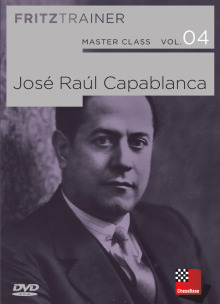 Master Class Vol. 04: José Raúl Capablanca - A Review
Master Class Vol. 04: José Raúl Capablanca - A Review
What a time for the chess fan! From the Czech republic to Dortmund, Germany, from Norway to Austria to Armenia, the sun never sets on chess. Whenever you open your computer, you have at least two top grandmasters playing somewhere in the world for your enjoyment and for the pleasure of your pet chess engine.
One highlight of the last months was the Capablanca Memorial in Havanna which was convincingly won by Chinese star Yu Yangyi. The Capblanca Memorial naturally leads one to remember the legendary third world champion and what a better way to learn about José Raúl Capablanca than the fantastic biography, written by Peter Schneider that accompanies the latest volume in the “Master Class” series. The first volumes were devoted to Fischer, Tal and Alehkine in this order and the fourth is devoted to Capablanca.
In the following review I combine chess legends with serious review of the new DVD. As far as a description of the DVD everything I say I stand behind but as far as telling the biography of Capablanca please know that all that you read is a myth and that if you want to know the history you should refer to a more reliable source, such as the aforementioned Peter Schneider biography. So, here goes:
The old storytellers of chess tell us myths about two players nicknamed “Capablanca.” I will start with the more famous one.
The sun was setting on the port of Havana, Cuba as two fishermen were playing chess in front of a shack. “Checkmate,” said Domingo, the owner of the shack after putting his queen on g7.
Lazaro, his guest and colleague, scratched his beard for a few seconds, trying to find a move but finally he spread his right hand and shook Domingo’s hand in acceptance of his defeat. “That’s enough for today,” he said and got up from his chair. “I think I’ll head back so I get home before dark.” But he lingered a little bit to discuss the heat. Both Domingo and Lazaro agreed that it was an exceptionally hot summer but while Lazaro thought it was the hottest he had ever seen, Domingo thought that the summer when José Raúl had been born, back in 1888, was just as hot.
“Who can believe that you are already four years old, José Raúl,” Lazaro said and caressed the hair of little JR, who had been standing beside the two men ever since they had brought the chess set outside. “Did you have fun watching dad and uncle Lazaro play the grownups’ game?” but without waiting for a response, the guest shouted a goodbye to the lady of the house and was off to the alley on his way back to his own home.
“Lazaro now owes me fifty pesos for chess,” said Domingo after the man had left.
“The last game does not really count,” his son said, lighting up a cigar, “because your fifteenth move was illegal, you moved your knight from b4 to e3.”
“That is crazy, José Raúl” the father said, his voice one octave higher than its normal pitch, “You’re only four years old. You don’t know the rules of chess, you cannot use algebraic notation because you never read and never will read a chess book and you should not smoke a cigar or it will paint your teeth yellow.”
“First, I still have my baby teeth,” said the boy and puffed out a ring of smoke, “which means I can enjoy cigars for another half a decade before I should worry about the color of my permanent teeth. Second, the use of algebraic notation was not something I actually used. It was added by the writer, A. Patzer, to make our conversation easier to understand for a 21st century reader. As for whether or not you had made an illegal move, I suggest we go over the game.” And with saying that, José Raúl Capablanca, at four years old, replayed the game out of memory and proved to his father that he, the son, knew the rules of chess and that he, the father, had made an illegal move with the knight.
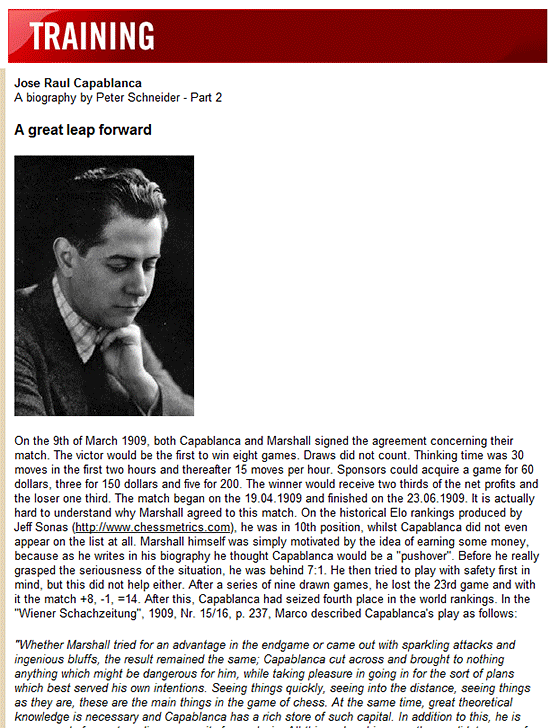
Extract from Peter Schneider's biography on Capablanca
Capablanca’s father was not the only one who was surprised by José Raúl, as you can see in the tactics section of the new Chessbase DVD “Fritz Trainer, Master Class Vol. 4: José Raúl Capablanca.” Volume 4 is the second DVD in this series that I review (see my review on the Alekhine DVD) and the immediate part I rushed to was IM Oliver Reeh’s tactics section. I just love those interactive puzzles, those little videos that tell you if you were right or wrong and the friendly laid back approach of IM Reeh.
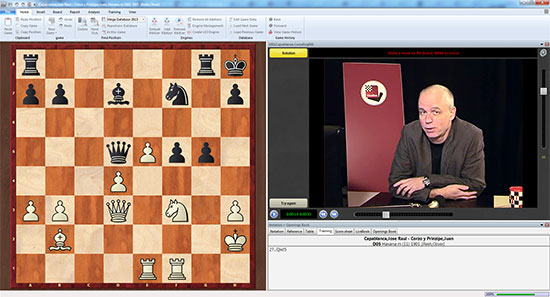
IM Oliver Reeh chose 24 combinations for the interactive videos In the above,
you have 13-year-old Capablanca about to blow apart Corzo.
You'll need more than the first move to solve it. White to play and win.
Unlike Alekhine who was characterized by monumentally complex combinations filled with sacrifices and usually culminating in checkmate, Capablanca’s combinations were nicknamed “petites combinaisons” (“little combinations”) – three or four move sequences that netted a pawn or some other “little” prize but actually changed the course of the game in Capablanca’s favor.
For those of us who watched the DVDs about Tal or Alekhine this may not sound exciting but in actuality it is. Take, for example, exercise 8 from Reeh’s section (Capablanca – Janowsky, New-York, 1918). After 19 moves you have a position where you know white is about to win a pawn and Reeh gives you a couple of other hints and still it took me a good five minutes to find the first move and I did not see it to the very end, four moves later.
I think what is amazing about these “little combinations” and what you learn from the tactical section of the DVD is to get a feeling for those positions that at first glance seem equal but in fact have a small window of opportunity for you to win. For most of us it takes some twenty exercises to get a sense of it. Only very few have, Like Capablanca did, the privilege of seeing these little combinations shortly after they learn the rules of the game.
At twelve, Capablanca won a match from Cuba’s national champion, at twenty-one he toured the USA, playing simultaneous chess exhibitions with results that shadowed previous results by Frank Marshal and Géza Maróczy and at twenty-three, at his debut performance in Europe, he won San-Sebastian, 1911, ahead of all the greats of the time, excluding the world champion Emanuel Lasker but including Rubinstein, Nimzowitsch, Vidmar, Schlechter and Tarrasch.
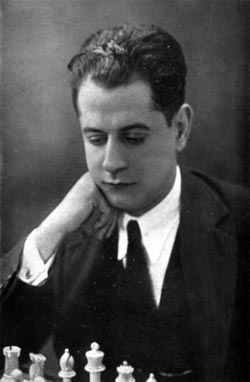
The young genius
It was during this decade, the 1910s, that Capablanca built his worldwide reputation as “the chess machine,” much thanks to his unparalleled mastery of chess endgames. If you know one thing about Capablanca after reading this review this one thing should be that Capablanca was an endgame genius. If you know one thing about GM Karsten Müller it must be that he is the most renowned educator in the field of chess endgame. (If you don’t believe me just google “chess endgames book” or “chess endgame DVD” and see what happens). In this sense this DVD is where your planets of chess endgame, Capablanca and Müller, line up. This is where one of the best endgame teachers teaches you about one of the best endgame players.
It is no wonder, then, that I had great expectations for this part of the DVD. I was looking for something unique and different and I am happy to report that GM Müller did not disappoint.
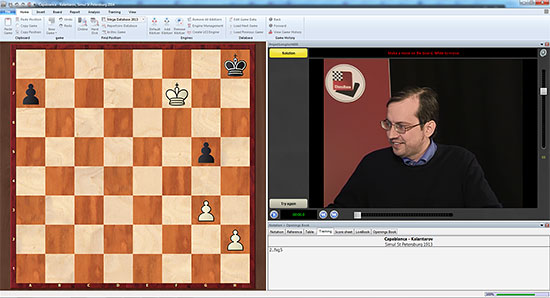
Karsten Müller enjoying the endgame.
First, I want to mention something that I think is new to GM Müller (or at least I did not see it in the Alekhine DVD). I am referring to Müller starting with two interactive videos, similar to Reeh’s methodology. The thing is that Müller knows so much about the endgame that every sentence he says is worth stopping and repeating and thinking about. For example, from his interactive video about the Capablanca – Janowsky, 1916, you can learn pretty much all that you need to know about bishop + pawn versus bishop endgames, if you just listen carefully.
At first, Müller suggests that you go and learn the Centurini drawing position, which I did, and you should too.
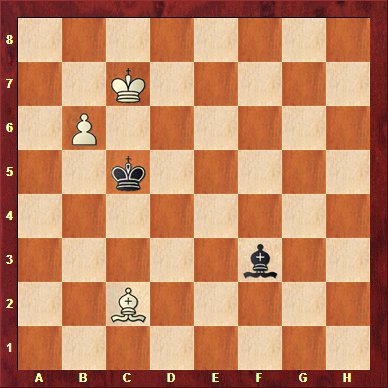
The classical Centurini position
Then you try to solve the position and even if you fail (as I did and as did both Capablanca and Janowsky in the game) you should watch carefully and continue playing it with the Fritz engine provided with the DVD, and at the end of the hour you will be rewarded with a full understanding of B+P Vs. B endgame.
The other videos are also wonderful in terms of both the games and Müller’s explanations but they are shadowed by the two new interactive videos. Truly you can pause the videos and guess the next move at certain point but this is not as emotionally satisfying as making the move on the board yourself and dreaming that you are Capablanca. This emotional engagement, I believe, creates an impact on our memory that makes the learning deeper. I think that GM Müller was “testing the water” with the two interactive videos and all that I can say is “please, Dr. Müller, jump into the water! We want more of these interactive DVDs, more, more, more.” Imagine a DVD by Müller, filled with interactive videos about the endgames of Vassili Smyslov. Imagine a DVD about the endgames of Magnus Carlsen! If these are not going to be instant classics then I am not “Little Capablanca,” which brings me to the other myth I was talking about earlier.
The other, less known, myth about a player known as “Capablanca” happened in a different time, on a different continent. Miss Novera Patzer (nee Nochessowitsch) was having her sister, Unjudit, for a lemon ice tea. Like all other middle class Israelis in 1975, they enjoyed the then new Wissotzky lemon ice tea. “In a hot day like this, a cold drink is a real life-saver. And this one also has all the health benefits of a tea,” Unjudit said. ”Who could believe that a tea could be drank cold?”
“There is no limit to human ingenuity,” Novera answered. “And thanks God,” she added, “the little Patzer is busy with the chess set and not bothering us.”
Neither sister knew how to play chess but like many other Israelis of their social class they owned a piano, all twenty six volumes of the Hebrew Encyclopedia and a chess set, just to “keep options open” for their children.
It seemed to Novera that her four year old son, Amia Patzer, was just seizing the opportunity. Sitting on the colder balcony tiles, the chess board open before him, Amia was moving the pieces back and forth, taking a piece off the board once in every few moves.
“Does he know the rules?” Unjudit asked Novera.
“Do you know the rules of chess?” the boy’s mother shouted the aunt’s question to the child.
“It’s black against white,” Amia answered.
“Are you black or white?” aunt Unjudit asked.
“I am Black.” The boy answered.
“And are you winning?” the mother said.
“White is attacking,” Amia said, “but I always win at the end.”
The two women sipped some more tea, and silently looked at the kid as he launched his little black army in counter attack, surprising white’s flank and eventually taking all of white’s pieces, including the king, off the board.
“He’s our little Capablanca,” the mother said, putting her right hand on her chest.
This was how the Little Capablanca of the Patzer family came into existence and this was the birth of the second Capablanca myth. The important point about this true anecdote for the chess historian is that even these two Romanian born women, living in Israel in 1975 and knowing practically nothing about chess knew the name “Capablanca.” Like Fischer, Kasparov and Carlsen in later years, Capablanca was not only a chess genius but one of the global celebrities of his time.

Capablanca on the title of Time Magazine, Dec. 7, 1925
As a celebrity (and some even say, a playboy) it is no wonder that Capablanca did not spend a lot of the time preparing what demands the most preparation – the openings. GM Niclas Huschenbeth talks about the openings and I like the easy way (Oh, the confidence of the young!) in which he pretty much shows that both Alekhine and Lasker were better in the opening than Capablanca.

GM Niclas Huschenbeth
For Capablanca, so it seems, the opening was just a way to get to a reasonable middlegame or even an endgame. For those of you who don’t have much time there are some ideas about how to play unambitious yet safe openings. I also hope that you are not so much in love with Capablanca that you are emotionally unable to learn from Alekhine because I think it is Alekhine who comes out as the star of this part of the DVD, especially as it concerns 1. d4. Personally, I don’t think there is anything bad about learning from the competition (unless you are more in the direction of playing only against yourself.)
Between 1916 and 1924 Capablanca did not lose even a single chess games, despite playing such notable tournaments as Hastings 1919 and London, 1922 and playing a world championship match against Emanuel Lasker (who resigned the match after ten drawn and four losses, although the match was originally set to linger until one player won ten games) All in all during that time Capablanca played some sixty official games winning or drawing each and every one of them.
This achievement was not surpassed until the times of A. Patzer who between 1975 and 1984 played thousands of games against himself, and won all of the games, despite being black on all of them and despite not knowing the rules of the game. It is a great doubt whether anyone can ever beat Little Capablanca’s epic fit.
Speaking of Epic efforts, I think I am spotting a grand scheme coming from GM Mihail Marin, who contributes the “strategy” portion of the DVD. Let me tell you a few things before I explain what I think that scheme is.
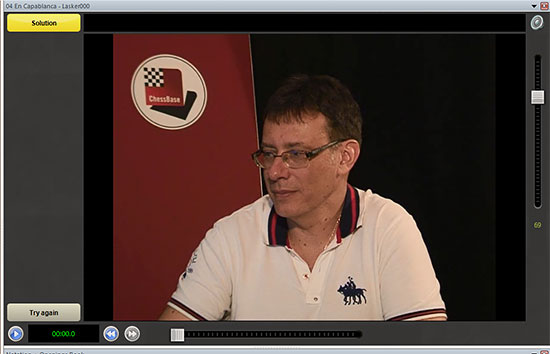
GM Mihail Marin
In his introductory video, GM Marin makes the announcement that Capablanca was more tactical than conventional wisdom tells us and at times Capablanca was even speculative. What is going on here? In the last DVD, Marin said that Alekhine was in fact a strategic player, now he says that Capablanca is truly a speculative player. What will happen next? Is Marin planning a DVD in which he will tell us that day is night and night is day?
When you look through the rest of the videos you’ll see that with the games he chooses and the interactive questions (more on that in a couple of lines) Grandmaster Marin may not teach us that day and night are the same but his bigger goal is, (that is clear once you watch both the Alekhine videos and the Capablanca ones) to free us, amateurs, from the artificial separation between tactics and strategy. It is not like there is no difference between tactics and strategy. These terms are still meaningful for the beginner but what Marin is teaching, through example, is that chess calculation and chess understanding are so intertwined with each other that you cannot talk about one without talking about the other. Dichotomies, such as “tactics versus strategic”, are not really useful for chess improvement or even chess appreciation. Truly, when you talk to someone who learns about chess history for the first time, it makes sense to say “Alekhine was a speculative player while Capablanca was a positional one” but once we go deeper, as we learn from Marin, either of the two, strategic vision and tactical ingenuity cannot exist without the other.
Another point that comes out when comparing Marin’s work on the Capablanca DVD with the one he had done for the Alekhine DVD is, as mentioned before, the added interactivity. Like Karsten Müller, Marin is “testing the water” of interactive video: Just before the crowning combination or a forcing move he sometimes stops and lets us, the viewers, make a try at making the next move. As always, I love it. It will never wear on me to find the last move in a World Championship Game, even if this combination is clearly much easier than the twenty moves that came before it. As I said before, making the move myself rather than pausing the DVD, just engages me to another level. Therefore, I would say to GM Marin as I said to GM Müller above, “give us more of this good stuff, please.” For example, I could imagine moments where he could say something like, “here white could either start actions on the kingside or in the center. Would you start a kingside attack with g2-g4 or would you open the center with d4xe5? Make one of these moves to show which strategic plan you choose.” This of course is not a specific position I have in mind but just an idea on how even strategic decisions could be turned into an interactive process, in which the viewer makes a move to “vote” for a plan.
There are always ideas for improvements but the beautiful thing about this series of DVDs is that it already is a great thing AND it keeps improving from installation to installation. Therefore, I suggest one of two options for my reader. If you want to learn from the myth of Little Capablanca, I warmly recommend my own DVD “1001 Ways of Checkmating yourself without Knowing what a Checkmate Is.” If, on the other hand, you wish to learn from José Raúl Capablanca, then I suggest “Master Class Vol. 4: José Raúl Capablanca.”
Sample video
 |
Master Class Vol. 4 - José Raúl Capablanca• Video running time: 6 hours (English) €29.90 This DVD can be purchased as a hard copy or it can be downloaded directly from the Internet. Order this Fritztrainer in the ChessBase Shop |